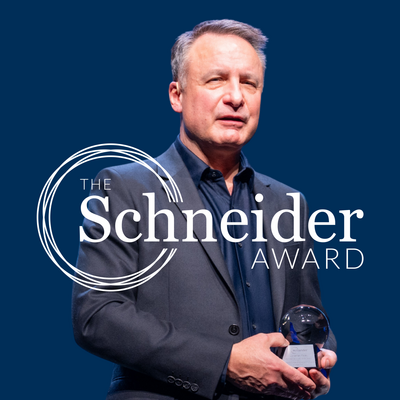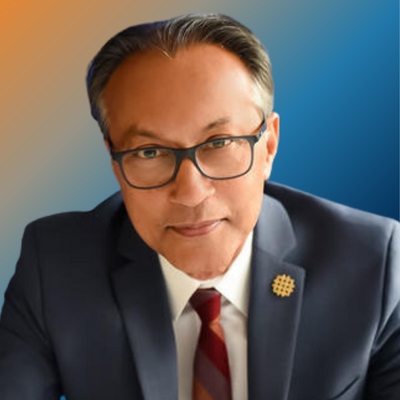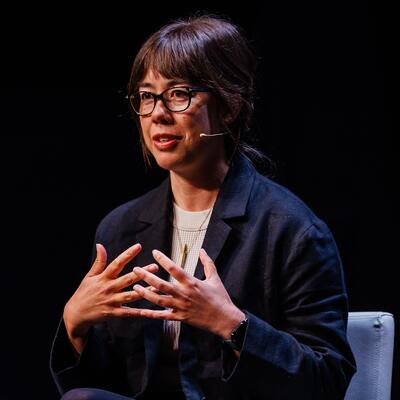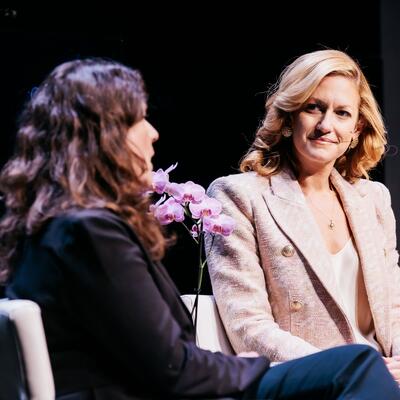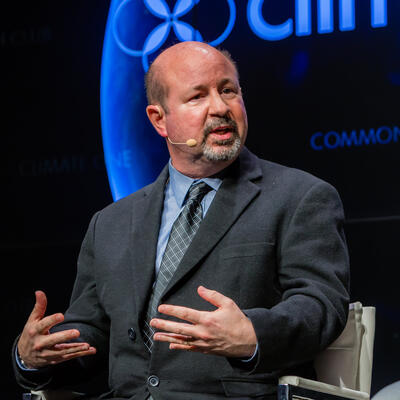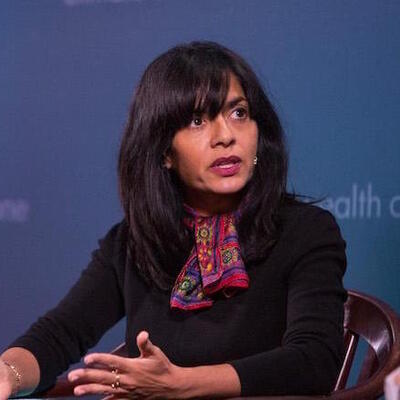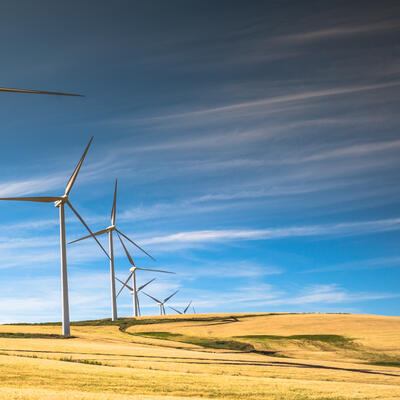
Drawdown: Do We Have What It Takes to Solve Climate Change?
Guests
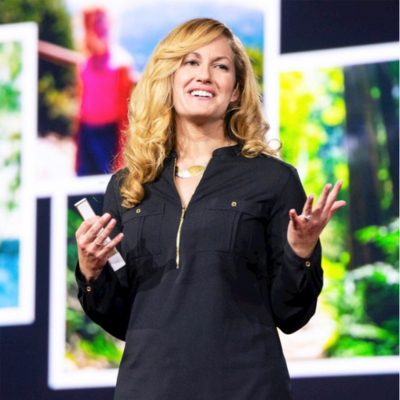
Kate Brandt
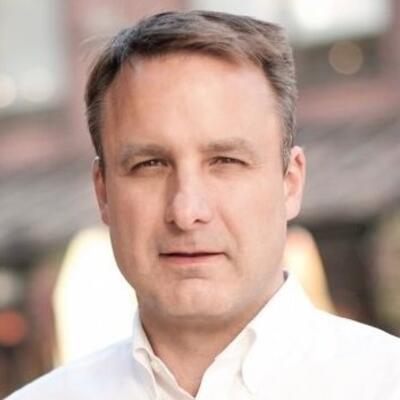
Jonathan Foley
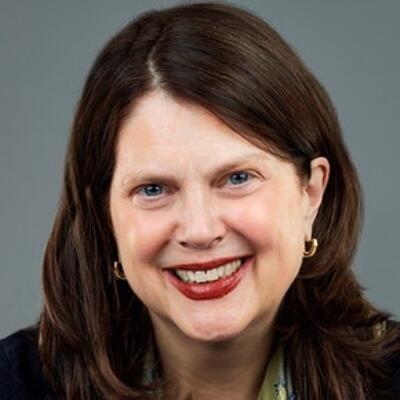
Lois Quam
Summary
When it comes to solving climate change, where do we start?
The organization Project Drawdown has published a list of top solutions for climate change – impactful actions already in existence that not only reduce carbon emissions, but also improve lives, create jobs and generate community resilience.
“If you’re thinking about how to solve climate change here's where you start,” says Jonathan Foley, Project Drawdown’s executive director.
“Electricity is about a quarter of the problem. Food, agriculture and forest are also a quarter of the problem...then you’ve got buildings, industry and transportation. Those are the five things we’ve got to change.”
One item that might surprise many is dealing with global overpopulation. And that starts with improving education and reproductive freedom for the world’s girls and women.
“If women have the opportunity to be able to have a voice and be agents in their community and their country globally, we have the opportunity to have the kind of innovation that we need to be able to combat this,” says Lois Quam of Pathfinder International.
“That human right to decide whether and when and how many and with whom we want to have a child, the ability to exercise that right is…one of the top strategies to combat climate change.”
It’s quite a to-do list – and it’s only the beginning. How to sort through the many daunting tasks ahead of us?
Don’t be discouraged, says Foley. It almost doesn’t matter where we start, as long as we’re doing something. Corporations, policy makers, communities and individuals all have a part to play in achieving climate drawdown.
This point was driven home to the audience and panelists alike by an additional guest, 13-year old Kea Morshed. His YouTube channel, Movies with Mic1, demonstrates the many ways we can all challenge ourselves to take action on climate change.
“At the end of the day, it's gonna be behavior change by all of us that’s necessary,” Foley tells Climate One. “It’s gonna be policy change, business operations change and changes in capital, money. “So don’t pick one lever, pull them all, you know - everybody bloody one you can find!”
This program was recorded in front of a live audience at The Commonwealth Club of California in San Francisco on July 11, 2019.
Resources From This Episode (5)
Full Transcript
Greg Dalton: This is Climate One, changing the conversation about energy, the economy, and the environment.
Jonathan Foley: If you’re thinking about how to solve climate change here's where you start.
Greg Dalton: On today’s program – tackling the “to-do” list.
Jonathan Foley: Electricity is about a quarter of the problem, food, agriculture and forest are also a quarter of the problem...Then you’ve got buildings, industry and transportation. Those are the five things we’ve got to change.
Greg Dalton: Solutions exist and many are economic with existing technologies. But some say it can’t be done without solving some underlying problems first – such as overpopulation.
Lois Quam: That human right to decide whether and when and how many and with whom we want to have a child, the ability to exercise that right is…one of the top strategies to combat climate change.
Greg Dalton: Drawdown – do we have what it takes to solve climate change? Up next on Climate One.
Greg Dalton: When it comes to solving climate change, where do we start? Climate One conversations feature oil companies and environmentalists, Republicans and Democrats, the exciting and the scary aspects of the climate challenge. I’m Greg Dalton. Project Drawdown has published a list of top solutions for climate change – impactful actions already in existence that not only reduce carbon emissions, but also improve lives, create jobs and generate community resilience. Besides the obvious – clean energy, saving the rainforests - the checklist also includes some surprising items, such as reducing food waste and improving educational opportunities for girls.
Lois Quam: If women have the opportunity to be able to have a voice and be agents in their community and their country globally, we have the opportunity to have the kind of innovation that we need to be able to combat this.
Greg Dalton: Lois Quam is the U.S. CEO of Pathfinder International, an organization that champions women’s education and reproductive freedom. But increasing access to family planning is just one piece of the puzzle. According to Jonathan Foley, Executive Director of Project Drawdown, it almost doesn’t matter where we start – as long as we do something.
Jonathan Foley: At the end of the day it's gonna be behavior change by all of us is necessary. It’s gonna be policy change, business operations change and changes in capital, money. So don’t pick one lever, pull them all, you know, everybody bloody one you can find.
Greg Dalton: But we’ve all got to start somewhere. How to sort through the many daunting tasks ahead of us? On today’s program, we’ll talk about carbon drawdown and how to achieve it: what should be done, what can be done, and what is being done. And hopefully you’ll come away with some ideas for your own climate to-do list.
My guests are Jonathan Foley of Project Drawdown, Kate Brandt, Sustainability Officer at Google, and Lois Quam. Quam started out in the healthcare field before joining Pathfinder International. But it was a life-changing visit to the Arctic, and what she saw there, that inspired her to take on the battle against climate change.
Lois Quam: I'm a Norwegian-American and I have three sons and I wanted to take them to meet their relatives in Norway. And a lot of my family in Norway lives in what they call the High North, the Arctic region of Norway in and around Tromsø. And I took my sons for that visit and something happened to me there that I didn't realize was gonna happen. In seeing the changes, in listening to people talk about the changes there and in Spitsbergen, which is I know a part of Norway you and I have both been to. And the way people would say well, you know, the ice is going away and the ice is going away. And I came back from that trip and I couldn't settle back into my life as I did before, I kind of try to. And I would say that every major decision I've made since that point has been affected by that trip. It got way inside me.
And what I'm doing now at Pathfinder came out of a realization that one of our most treasured human rights is also a tremendous way to combat climate change. And that human right to decide whether and when and how many and with whom we want to have a child, the ability to exercise that right is as Drawdown shows, one of the top strategies to combat climate change because it enables women to be innovators, women to make different decisions about their lives and about their families. So like you it was really seeing that firsthand and I think being with my young sons and thinking about the future I wanted for them, and kind of like what was I gonna say to them when they were grown if I didn't invest in this work.
Greg Dalton: Jon Foley. Environmentalists, the climate conversation is a lot about smokestacks, tailpipes, chemistry and physics. Not a lot about gender issues, women's reproductive, you know, Drawdown puts a couple of those are in the top 10 I think. So tell me about the inclusion of those and the reception to, and oftentimes there’s approach of, oh population control.
Jonathan Foley: Yeah, can we all agree that those two words should never be uttered in the same sentence again? Especially by white men.
[Laughter]
So, you know, and Lois is the real expert here so it’s silly for me to talk about that. But we did a little bit of the math saying it isn’t just the carbon footprint that matters, it’s also the number of feet, right. And also, as we think about, you know, are we gonna live in a planet of 8 billion, 9 billion, 10, it will matter. Now middley, a lot of that population growth will be in some of the poorest places in the world where the carbon emissions are far less than let’s say ours in this room for example. But nevertheless, if billion people more or less is billion people more or less, that’s huge. And so we did find that when you think about the things that are really the positive levers for change that also affect reproductive trajectories in the future like educating girls, access to family planning, things that Lois and others have dedicated their lives to was also intersected with climate solutions as well. In fact, when we put kind of women and girls solutions together they become one of the most powerful things we can do. And it’s not just on population by the way, there's other things that women disproportionally have a role in: smallholder farming. Also in collecting fuel wood and what’s cooked at home, food waste, water decisions things like this and especially in the developing world. So I think there's a lot more there but Lois and I have talked about this before the communities kind of think about climate change, the communities to think about kind of reproductive health and women's rights.
We haven’t learned to talk to each other quite yet. We need to kind of come together because we’re often talking about very similar issues and when we discover that it's very exciting.
Greg Dalton: Kate Brandt. Gender equity and opportunity is a big issue in tech. And I’m curious -- you work at Google, if the gender conversations are separate from the sustainability conversations if they ever connect.
Kate Brandt: I think for us to actually where the issues intersect the most is almost all the women leading are sustained, almost all the people leading our sustainability work at Google are women. But I have noticed this not just at Google but across a lot of people that are leaders in the space we’re increasingly seeing women taking leadership roles. So I think obviously the tech and gender conversation is critical it’s not part of my remit but I feel really proud that so many of the people that are leading this work for us and at other companies and at other organizations are women.
Greg Dalton: And what are some of the big levers that you have at Google to get at greenhouse gas reductions because it’s so big. What are some of the big levers?
Kate Brandt: Yeah, so for us at Google we have initially really started with our own operations. So really dating back to our founding 20 years ago now, our founders have always deeply cared about this issue. And so it's really grown-up inside of the company inside of how we operate the business. And some of the big levers we have are how we use energy.
So as you probably know, you know all the tools and services we use every day, YouTube and Gmail, are run in data centers and data centers use a lot of energy. So from the time we started building our first data center over a decade ago we’ve been laser focused on not only how do we build them as efficiently as possible, but also how do we ultimately move towards clean energy. So we've been carbon neutral since 2007 and we've been on a journey of procuring renewable energy and so we are now matching a hundred percent of our energy with renewable sources. But along the way it's been really important to us to figure out how do we drive policy change, how do we enable more clean electrons to get on grids all over the world, so that we cannot only meet our goal which is to be a hundred percent renewable, but actually to help green grids to bring down prices so that we can all more move towards a carbon free future.
Greg Dalton: Greenpeace has a project called Click Clean that evaluates the cloud and data centers of a lot of different businesses. And they issue grades regarding renewable energy, their advocacy and transparency and Greenpeace issues grades. Netflix, D. Vimeo, D. Hulu, F. HBO, D. Amazon Prime, C. They’ve been improving lately. This one hurts. NPR, F. Pandora, F. SoundCloud, F. YouTube, A. So let's give it up for YouTube.
And that’s coming from consumer pressure. So, Kate Brandt, why do those other companies lag so much I mean consumers seem to care about this stuff it's not getting through.
Kate Brandt: Yeah, I mean I think that we’re increasingly seeing a lot of companies doing great work in the space. I think we've seen a tremendous uptick across the tech sector in many sectors but there is clearly a lot of work to be done. And I think hearing that expression from consumers and users that this is important to them is critical because that will move the needle. I think that along with investor interest and interest of employees this is becoming increasingly important topic for employees for attracting or retaining talent. So I think we’re on the right trajectory but there is definitely more work to be done in the corporate sector. And I think for us too it’s not only how we are operating but also how we can use our technology to enable everyone to drive action too. So I think we have multiple opportunities.
Greg Dalton: The third rank solution on Project Drawdowns list is reduced food waste. They estimate a 50% reduction of the world’s food loss and waste would cut the equivalent of 70 gigatons of carbon dioxide emissions. Reducing food waste takes on many different forms. In developing countries food often doesn't make it to hungry people because of storage or distribution problems. In the U.S. and other wealthy nations we simply throw out lots of food.
City Harvest rescues high quality food in New York City that was being discarded in perfect condition, provides it to hungry people. It’s been operating for more than 30 years and inspired other organizations around the country. But senior organization specialist Kate MacKenzie says it's only been in the last decade that their work is being recognized for its climate positive effects.
Kate MacKenzie: Since City Harvest started rescuing food we've prevented about 600,000 metric tons of methane from being released into the air. And that's the equivalent of taking about 100,000 cars off the street for a year. Really starting in 2010, 2011 the movement of connecting the production of food the way food is grown the local food movement and doing more with less, as it connects to climate change really started to take hold.
I remember having been in the space for a while when it was seen as well there's the environmental folks the food waste side and then there's just the anti-hunger community. And increasingly, I would say particularly over the last 6 to 7 years the two have really merged. So it’s no longer conversation of you either care about food waste or you care about food insecurity it’s a very large problem of hunger it’s a very large problem of food waste. And if we can solve both together, that's fantastic, but the two sides do need to be talking together.
Greg Dalton: That was Kate MacKenzie with City Harvest in New York City. Another example of co-solving problems that aren’t connected but can be connected.
Now for another take on waste we turn to a middle school student, Kea Morshed. After observing how much trash his family produced, Kea decided he was going to do something about it. He joined the ‘trash on your back” challenge and wore his own trash on his back for a week and documented the whole process on YouTube. Kea, come on up. Welcome. Kea, what prompted you to carry your trash on your back for a week?
Kea Morshed: Well, I'd say about a year ago I was walking near the Berkeley Marina and I saw a big clump of trash there. And that as well as seeing how much trash me and my family produced in a week I decided to do the trash on your back challenge.
Greg Dalton: And so you have this plastic bag and what was the reaction of some of your friends when you started wearing around this little plastic bag with a couple of pink strings on it when you went to middle school with that. You’re 13, right, so you went to middle school. How that played?
Kea Morshed: Well, I mean at first I think most of my friends were actually pretty confused about it. They didn't really know what to say at first but and, you know, I got some weird looks from strangers on the bus. But eventually people started asking me what it was about in a way I felt like I was kind of inspiring people do this challenge and reduce their waste by seeing how much they use.
Greg Dalton: It’s a conversation starter so you got to talk to people about their own use. And did any of your friends volunteer to join you?
Kea Morshed: Yes. I had a few friends and also I encourage everyone here to take part in this challenge as well.
Greg Dalton: Pretty good. So what do you think is the impact of this what came of it for you, what came of it for people that you interacted with?
Kea Morshed: Well, I think climate change is kind of a depressing thing and a lot of people are kind of scared of it. So I think a challenge like this shows us that we can bring some fun to like reducing our plastic waste plastic usage. And so yeah, I think that's something I'd like people take away from a challenge like this.
Greg Dalton: What's next for you? You have a YouTube, you can check him out on YouTube, what’s your --
Kea Morshed: Movies with Mic1.
Greg Dalton: Alright, let’s give it up for Kea. Thanks for doing this. So reactions to the youth and the waste, Lois.
Lois Quam: Congratulations and thank you for inspiring us. In my work for Pathfinder I get to travel around the world and meet with a lot of young people. And I think that the innovation required to combat climate change is in front of us. If we can tap into the creativity and talents of all of humanity. And I often get as you're asking Jon, you know, why do people, how is women's empowerment and contraception and family planning connected to climate change? And the most powerful way is that if women have the opportunity to be able to have a voice and be agents in their community and their country globally. We have the opportunity to have the kind of innovation that we need to be able to combat this.
Because as we know and you know a lot about it in this part of the country innovation often comes from outside the places of power outside the places that have created the circumstances is disruptive, it comes. And for most of humanity and in most places women are outside of that and have life experiences and intelligence and creative activity to offer to that. Yet, it's very difficult to offer that if you don't have the opportunity for contraception.
And then if I could just add one point which speaks to the number of feet that Jon referenced is globally 45% of all pregnancies are unintended. And the best estimate says, that if every woman had contraception when she wanted it and we know hundreds of millions of women want to use contraception and don't have regular access or any access to it. That number would go from 45% unintended to 7% unintended. And the Wittgenstein Institute in Austria just did analysis of this, and they looked at two different world outcomes. One, where we invest in girl’s education, where we invest in family planning and other ways to build people. And the other where we principally invest in security and defense and antiterrorism. And they estimated that in this strategy where we’re investing in people including family planning, that about the middle of this century, the population would actually go below where it is now, below 7 billion. And in this strategy where the investment is in security, but not in people, that population size will be about double that around 13 billion.
So the opportunity to exercise this right that we’ve had is so key to combating climate change, that I wasn't surprised when Drawdown found that that combination of girl’s education and family planning was the single highest way to get there.
This is about a human right. And it's about everybody's human right to make these kind of decisions about their life and they have the tools to be able to do that. And from the very beginning Pathfinder is community-based. So I was in Ethiopia last week and my team in Ethiopia is all Ethiopian. When I go to -- I was recently in Niger and I was in a village outside of Zinder, Niger and my team there if from that village. It is not possible to do this work by coming in from the outside because this work is deeply cultural. We don't require our staff to have English most of our staff will have to speak the local language because their job is to work with their neighbors to create the space so that people have options in their life and can exercise their rights.
Greg Dalton: You’re listening to a Climate One conversation on doing what it takes to combat climate change. Coming up, using the right tool for the job.
Jonathan Foley: The one thing you have to remember about climate change is there isn’t one thing about climate change; it’s a whole bunch of things…We can have different tools for different kinds of problems. And when you do that I think it becomes a lot clearer what’s next and where we need to focus our attention.
Greg Dalton: That’s up next, when Climate One continues.
Greg Dalton: This is Climate One. I’m Greg Dalton, and we’re talking about cutting carbon emissions, by whatever means necessary. My guests are Jonathan Foley of Project Drawdown, Kate Brandt of Google, and Lois Quam of Pathfinder International.
We know that change can happen one person at a time, or even one village at a time, as Lois Quam was telling us earlier. But can that happen fast enough to stabilize the climate that supports our lives and our economy? Jonathan Foley talks about bridging individual change with systemic change.
Jonathan Foley: Well, when you think about systems in general there’s an idea like fractals. You know there’s patterns of organization that happen to all scales so change doesn’t happen just at the top or just to the bottom. It’s often from the middle out. And so I think that’s the mistake we sometimes make that, you know, yes, one individual out of 7 billion just doing it all by themselves may be virtuous but not very effective. The waiting for the UN for 30 years or Washington to just save us from ourselves that hasn't worked out too well either. And so and it’s not going to, you know, frankly, I don’t think, I’m done waiting for them. So let’s look for other levers and I think to really achieve drawdown we looked at a hundred solutions. And we actually looked also it’s not in the book but we look at the what we call the level of agency, kind of, you know, what lever gets pulled to make that happen. And sometimes it’s international policy, sometimes it’s national, often it's local.
Some of the most important people in the United States around climate change are people you've never heard of. They are the people who’d share Public Utilities Commission they’re the head of your zoning boards. They’re people who are often how Harvey makes this point a lot too.
The policymaking is often rule-based in local communities, states and counties and we don't talk about that but that's huge. But also the individual level what you do does matter. This 13-year-old kid just inspired the room full of people I mean that mattered a lot, you know, that's what we need more of this do the good stuff then inspire other people through social media through talking about it. So our mutual friend, Katharine Hayhoe, who's a wonderful climate communicator and scientist says the most important thing we can do about climate change is talk about it. And she's right but at the end of the day it's gonna be behavior change by all of us is necessary. It’s gonna be policy change, business operations change and changes in capital, money. And we’re gonna need all of that otherwise we’re just fooling ourselves. Don’t pick one lever, pull them all, you know, everybody blood one you can find.
And also recognize where there are successes and build on them. For example, we sometimes get really depressed about this stuff but the U.S. actually hit our peak emissions in 2007 and they’re been going down since, we’re at 15% lower than we were in 2007. It’s a little uptick last year but I think it’s temporary. This is amazing. California, we’re making huge progress we’re the fifth largest economy in the world and we've committed to carbon neutrality completely by 2045. The largest economy on earth to do so by the way. New York State just matched us on this as well, made it a law not just an executive order. And if you just take California and New York together that’s a quarter of the U.S. economy. Two states, that's not bad.
So, you know, so individuals matter local places matter, cities matter it basically all matters. I know that sounds trite but it’s true. But where the exciting things is where those boundaries start to cross for individuals like you and others can inspire a bunch of other people whether they are in business or a local policymaking or maybe all the way to Washington or the UN. We just need all of this all the time merging and mixing together like crazy.
Greg Dalton: And speaking of policy, Kate Brandt, recently there was a number of executives from companies that went to Washington DC from eBay, Gap, Nike, Microsoft, Salesforce, 21 Fortune 500 companies calling for a carbon price, calling for climate action. Google wasn’t part of that. So I’m wondering you know how much you engage on policy because one of the things that people like Sheldon Whitehouse and others say in Washington DC as tech companies are great with the consumers great with innovation but when they come to DC they talk taxes, visas, immigration. Now I think tech is worried about being, big techs being worried about broken up. Where does climate rank?
Kate Brandt: Yeah, I mean as I mentioned before we’ve been engaged on policy for a long time. And I think to Jon's point, yes federal policy is of course important, but also we've been engaged at the state and local level working with PUCs, working with utilities to try and push the bounds of access to renewable energy, which is greening grids in local places. And equally, you know, we have gotten engaged on federal policy we signed an amicus brief around the clean power plan. We have engaged at many of the climate negotiations to share businesses perspective on why this makes business sense why we need to move in this direction. So we absolutely think policy change is a critical piece of it, but we also want to be really strategic about it. We want to use our voice where we think we can have a lot of impact and so that's gonna be in multiple places. But a lot of times it’s actually more at a local level.
Greg Dalton: If you’re just joining us we’re talking about sustainability at Climate One with Jon Foley, Executive Director Project Drawdown. Kate Brandt, Sustainability Officer at Google and Lois Quam, CEO of Pathfinder International. I'm Greg Dalton.
Jon Foley, I’d like to talk to you about the obstacles to some of the drawdown levers and the mindset the idea. This touches on Lois too a little bit some of the gender issues, you know, Carol Dweck at Stanford has the idea of a growth mindset fixed mindset. Because if humans were just rational and implemented all the solutions that you identified, we’d get the job done but that's not happening. So tell us about the mindset obstacles.
Jonathan Foley: It really sucks, you know what I’m saying. It’s been a real problem. Well we look at it, you know, we can throw our arms in the air and say, well, this is the world we like to have but this is the one we do have. And what we need to do I think is be just really pragmatic is, you know, and in Drawdown we look at like a hundred different solutions but they boil down to like five big areas.
If you’re thinking about how to solve climate change here's where you start. Electricity is about a quarter of the problem, food, agriculture and forest are also a quarter of the problem but don't get nearly as much attention. Then you’ve got buildings, industry and transportation. Those are the five things we got to change, okay. So electricity I think is well underway because it's not policy so much now it's markets. Solar, winds and batteries are just getting really cheap. Companies like Google are putting billions of dollars into this and scaling it up. That's happening really beautifully all over the world. We’re beating fossil fuels on the market, not because we put a thumb on the scale they’re just better technologies. You know, Amory Lovins used to say, you know, the Stone Age didn't end because we ran out of stones.
The coal age didn’t end because we ran out of coal. It ended because it’s bad technology. So I think electricity I feel like we’re heading in the right direction.
But other sectors like food and forestry and land-use we see some good movement like the video on food waste. That's the best place to start about a third to half of the food grown on the planet is used. So that's a human tragedy as well as environmental tragedy because it means half of the food's resources land, water, energy and materials were also wasted. So that's a good place. Diet changes are gonna be important. Stopping deforestation which Google by the way, revolutionized the way scientist contract deforestation around the world and gave it away for free. We can beat up on big tech but sometimes they give back in big ways. So I want to acknowledge that, that’s huge, changed what my community does hugely.
So there are a lot of good things happening. The ones I worry about though are around buildings and transportation because there's always a time lag. Today, you might see somebody buying a new Tesla but for every new Tesla there’s five SUVs being sold today, still, right, well I don’t know what the number but it’s more than five. And they’re gonna be on the road for about 20 years before they end up on a landfill, 17 years in California. That's a long time to wait to turn over the car fleet. And then you think about buildings; this is a beautiful new LEED building but for every new LEED building you build there’s thousands and thousands of buildings that are kind of old. What about them? And the deep energy retrofits they’ll need, that will take about 20 years as well. So that’s kind of when I look at obstacles I see where markets are, you know, you got to think like a tech industry you think about stage gaining. Like what's the most limiting thing between today and success. Is it policy is it markets, is it capitals is it rules, is it technology and so on. And I think we have to knockdown domino by domino by domino in very different ways.
And the same tool doesn’t work for everything it isn’t a hammer because these aren’t all nails. Electricity, it’s markets and scaling in investment in food I think it is gonna be regulatory we’re gonna need rules to change food waste and diet, it’s not just good feelings. That’s starting up and we’re gonna need rules we’re gonna need policy change but maybe to be local, I don’t know. We need a lot of attention in the Amazon right now because Brazilian deforestation had been going down for decades and now the change in government it may go back up very quickly. If I had a hundred million dollars right now I’d hire a lot of lawyers and descend on Brazil and not leave. That will be huge, save the Amazon from their own government will be huge. Working with indigenous communities and environmental groups.
So I think there's different tools for different problems. So when I feel like we’re getting stuck, I think we have to zoom in a little bit more and be more granular in the problem. We can’t just say climate change has one solution. Our founder is Paul Hawken, and he likes to say, the one thing you have to remember about climate change is there isn’t one thing about climate change it’s a whole bunch of things. And so let’s click down one more click and go from climate change to oh, it’s electricity, that’s the tool for electricity. It’s food, it’s buildings it's cars and it’s industry. We can have different tools for different kinds of problems and when you do that I think it becomes a lot clearer what’s next and where we need to focus our attention.
Greg Dalton: Lois Quam, what are the obstacles that are preventing women from having the agency and human rights that you identified?
Lois Quam: Well, I think for many women around the world it is not having reliable and regular access to family planning and not being able to be educated. I think about a recent experience I had in Rio], Niger just outside of Zinder, Niger. And I was meeting with a group of 15-year-old young women and they were all married and they had all had their first child. And so they didn't have the chance to grow up before they had their first child before they were married. They didn't have the chance to get a high school level education. And they were intelligent and creative and interesting people. And the expression on their face when my colleague whose part of their community, my Pathfinder colleague was sharing with them in-house in their local language the fact that they could wait to welcome their second child because historically, many young girls have had two children in the space of a year when they're first married. But the look on their face the sort of light on their face with this idea that they could wait a couple years before they welcome their second child.
So one of the things and Jon and I have talked about this that's really challenging is in the case of family planning we have the technology and we know how to implement it. It can't be this outside invasion it has to be in the community but we've done this work at Pathfinder for decades and decades and decades. So why hasn't it happened? I think the first thing that time and attention and money is does not go to the places that really matter to women. The work that really matters the most to women is always under invested. And so often it becomes a sort of private matter for women to find her way through. And this is a moment that I think each of us men and women in this country have had the opportunity to have these services have to reflect on the differences made in our own life and give the opportunity to another girl or boy or man and woman elsewhere in the world with the same energy and hopes and dreams for their life that we have.
And I think that now is a moment that companies and individuals and the environmental movement and the reproductive health movement, we need to come together to get this done to put the resources in place with this proven technology in the hands of every person, because it makes no sense that today 45% of pregnancies are unintended.
You know, it is up to us to step forward to create this opportunity for others because the innovation to address all the challenges that Jon pointed out, it exists it needs to be unleashed around the world and half of humanity women need to be fully at the table.
Greg Dalton: I'm Greg Dalton. My guests are Lois Quam, CEO of Pathfinder International, Kate Brandt, Sustainability Officer at Google and Jon Foley, Executive Director of Project Drawdown. We’re going to the lightning round, true or false questions for our guests. True or false. Kate Brandt, green washing is prevalent in Silicon Valley?
Kate Brandt: I would say no in my experience, I think there's actually kind of an allergic reaction to green washing, certainly for us at Google. But I think at other companies at Silicon Valley too.
Greg Dalton: True or false. Kate Brandt, the U.S. Navy made more progress on clean energy during the Obama administration than any other part of the federal government.
Kate Brandt: True.
Greg Dalton: Jon Foley, true or false. The Green New Deal is realistic and viable?
Jonathan Foley: Oh gosh. No, it could be at the local level, but at the federal level I think it's more of an organizing principle and needs some work. But it will inspire lots of other actions which should be great.
Greg Dalton: Lois Quam, true or false. The Catholic Church is one of the biggest obstacles to women recognizing full rights over their bodies and reproductive choices.
Lois Quam: One of the biggest. We actually work with Catholic communities in Africa and make real progress. And we work with religious leaders, we organized the writing of the Cranach guide to family planning. So, our
Greg Dalton: It’s not a monolith of course the Catholic Church, it’s a big thing it’s like --
Lois Quam: Yeah. Our strategy is to work with religions to create these rights.
Greg Dalton: So a nice way to say, maybe?
Lois Quam: Yeah.
Greg Dalton: Sometimes. Let’s give them a round of applause for getting through the lightning round.
Greg Dalton: You're listening to a conversation about finding solutions to climate change. Coming up, can we be smarter with water?
Jonathan Foley: I used to be a professor for 20 years and I used to ask my students, could you invent a machine that wastes water faster than center-pivot irrigation? In 20 years, nobody's done it.
Greg Dalton: That’s up next, when Climate One continues.
Greg Dalton: This is Climate One. I’m Greg Dalton. We’re talking about big and small changes that could help us win the battle against climate change, with Kate Brandt of Google, Lois Quam of Pathfinder International, and Jonathan Foley of Project Drawdown.
All the Democratic presidential candidates this year favor action on climate, with many of them voicing support for the aspirational Green New Deal. Is all that newfound awareness a good thing for progress? Or does the theater of politics distract from actually getting things done?
Jonathan Foley: Well, I mean it's always good when you hear climate change on anything, I'm happy, you know, that’s good. I'm really glad that this is happening in Washington finally, or maybe another wave of it. AOC for example has been, you know, amazing on this issue in terms of raising the level of rhetoric and the Green New Deal has been a great organizing principle around that. But I do worry if we all put our eggs on that basket, I was like, oh I’ll wait for Washington to save us. I have these kind of flashbacks to 2008 where we had a popularly elected, you know, Barack Obama with a very large majority in the Senate and the House, and you guys were there. We still can’t pass a climate deal then when it was very easy political landscape compared to today.
So I just don’t think a single masterstroke of legislation of a Green New Deal signed by, you know, this president or maybe any, is gonna happen right away. So we’re gonna have to look for local and state things in the meantime and the U.S. is making progress. Whether Trump says coal is back, doesn’t matter, coal is gone it’s not going to. So a lot of these things are just gonna happen anyway.
And so I think it’s great to have this political rhetoric in Washington but I think we get seduced by it a little bit. There’s a lot of kind of beltway head in the media and there’s a lot of, you know, Eisenhower warned us about the military-industrial complex. I think we’re much more in danger of the media political complex today. Not here but, you know, we kind of we just hear a lot of barking and not a lot of action, especially in DC and it’s covered constantly and it’s stressing us all out. I think I’d rather get my hands dirty doing something real right now in your community in your state and see what can happen and let’s sort of tipping the scales wherever we can. With that said, we definitely need every national capital be part of this conversation as well we just can't wait for them anymore. And Washington's never really led on big issues like this, like marriage equality other things it happens in other levels and finally arrives at Washington later so let’s continue that. It’s a larger social movement as Lois is saying and let’s make sure that happens and is received by Washington not led by Washington.
Greg Dalton: Well, Kate Brandt, a lot of businesses are not waiting for policy they’re moving for economic and self-interested reasons, I’d like to hear you on that. And also whether you're operating in other countries because other countries have not slowed down like the U.S. has. Europe is going forward, other country, China is moving forward, so do you see leadership in other countries?
Kate Brandt: Yeah, absolutely. I think, you know, I’ve been incredibly heartened by the amount of action that we’re seeing by businesses. We recently, we’re founders of an organization called REBA, the Renewable Energy Buyers Alliance. And this is about 200 companies that have come together to push for getting about 60 gigawatts of renewable energy on the grid in the U.S. by 2025 and along the way, engaging with policymakers and driving this change together. So that is a great example of overseeing business action that's really driving change. And you're absolutely right, in Europe for example, they’re much further along on climate policy and we have the ability to do even more there to enter into new kinds of joint agreements with many companies to get wind on to the grid. And then the last still we’re there to make our voice heard with policymakers that this is an important business priority for us that we're seeing not only that this is good for us because it enables us to operate as a clean energy company but also it's enabling there to be positive change and business sense this makes sense for us from a hedging our prices we’re locking in long-term prices of clean energy, that has a very strong business case for us. So I think that's tremendously important.
Also, I think there's a huge role for technology companies and other companies to enable policymakers. So some of the work that we've done that I’m the most proud of is creating tools for policymakers that give them the ability to drive change. So one great example is a tool that we launched last year called The Environmental Insights Explorer. This is for cities not big cities, wonderful cities like San Francisco that have whole teams that can work on climate action planning but for smaller and medium-sized cities who don't have the capacity to do a greenhouse gas inventory to set climate goals. So we're trying to create tools that are freely available to enable policymakers to drive that change in their own cities.
Greg Dalton: There’s another example that meant a lot locally, you know, we've had a lot of smoke from wildfires recently. The way the air quality is measured by the EPA there’s like one sensor in the city. Google's partnering with some companies are I think to put the cars that drive around, Aclima, is a company based down the street. So tell us about that brings, that can tell you about the air quality on your block, very local which is much more meaningful when there's a fire and other time and bringing data and I think the polluters don't like to be kind of to know, right, because they can out individual sources.
Kate Brandt: Yes, so you're absolutely right. In a lot of cities you might have one or just a handful of air quality sensors and they’re gonna be stationary on a few buildings. So through this project, this called Project Air View, we partnered with the Environmental Defense Fund and a great local company called Aclima to attach air quality sensors to our street view cars. So these sensors can measure things like NOx, SOx particulate matter CO2 and give you a street by street picture of air quality. So we did this across the Bay in Oakland and we're able to create a data set that shows where those hotspots where air quality is the worst and often that’s in some of our most vulnerable communities. So we think tools like this can be incredibly powerful in giving people really actionable data that they can use to drive change.
Greg Dalton: We’re gonna go to our audience questions. We’re talking about sustainability and drawdown at Climate One. Welcome to Climate One.
Female Participant: Lorie Sinsley. This has been a fantastic conversation. This question is really for Jonathan. One of the things that you talked about was capital as a lever and finding solutions that work and building upon them. And then your other comment about philanthropy could be more effective. I'm interested in finding out how to identify projects, solutions, that are working to invest in.
Jonathan Foley: Funny you’d ask that. So you’re in the most important city in the world for climate philanthropy. A lot of the big foundations that fund the climate philanthropy are here. There’s also a consortium of the largest of the climate funders called ClimateWorks which is right here in San Francisco. And they’ve launched another initiative called the Climate Leadership Initiative which is trying to get, you know, ultra high net worth individuals, many from tech to become climate philanthropists. Because there’s about a billion dollar a year now I believe in climate philanthropy, should be ten, should be a hundred. That’s more than venture funding by the way in energy and climate philanthropy is far more important than venture funding right now in terms of absolute dollars. Both need to radically increase. So that's really, really important but what I worry about is a lot of them in about 80% of the money is going to 20% of the atmosphere. So much of it is just going into electricity and batteries because that's a nice tech problem. Not into women and girls at all, as I mentioned or food waste or, you know like shifting diets, although Impossible Foods, Beyond Meat, they’re getting a lot of attention now as plant-based substitute. So I think we need to kind of align the money with the physics.
And so one of the things we’re trying to do in drawdown 2.0 we’re gonna be developing a lot of investor guides and philanthropy guides. Saying, hey, if you’re gonna spend a billion dollars in climate change maybe you should stop and think about the physics and the chemistry for just 20 minutes. So just like a little course, like here’s where the gases come from here’s where you might want to think about your investments. Again, I think there’s a lot of just education and connecting the dots and building kind of a rolodex so people can help each other. And that's where we’re gonna make some big, big differences and San Francisco is ground zero for that. It’s gonna be great.
Greg Dalton: Next question. Welcome.
Male Participant: I had a comment that I like to see what you think about this. I mentioned one time I met Naomi Klein in New York and I said I think the American people are negotiating with our leaders. And American people's point of view is that if climate change is so bad why are you all still flying around. And I had suggested a no-fly Wednesday where all commercial airliners not fly every Wednesday could be a Sabbath, a flying Sabbath. And I wrote to a lot of airlines and they were polite...but I’m curious what you think about it.
Greg Dalton: Thank you. The idea of personal action we’re all conflicted people fly, right Jon?
Jonathan Foley: Yeah, you know, for the average climate scientist you know definitely flying is the biggest single part of their personal carbon footprint no question. But when you look at the whole atmosphere, aviation all the planes in the world is about 1% of our emissions. But it’s getting far more than --
Greg Dalton: Growing quickly though.
Jonathan Foley: This is true. But I think the benefits of international travel and learning about the world are pretty good. There’s a lot of really stupid things that emit, like food waste, nobody benefits from that or clearcutting the Amazon. But I think it’s good that people see other countries. With that said, aviation has gotten more efficient the fuel efficiency per passenger mile is doubled in the last 20 years and there will have to be alternative ways to fly. I don’t think just telling people you can't do something that's really great is a good solution when there might be other technologies. There will be some electrification of small planes that can be, now it can be battery-powered small planes, long ones will have to be some kind of sustainable aviation fuel. I think we’re clever enough to be able to do that. I’d like to live in a world where people can still be interconnected and visit each other without destroying the atmosphere. So let's figure that out because I don't think sacrifice is a good way to build the future because people aren’t gonna do it.
Greg Dalton: Next question, please.
Female Participant: Hi. I was in Montana at Yellowstone National Park couple years ago and we had a presentation by a hydrologist. And I asked him, I said since we have this big problem with water why do I see these farmers and ranchers having these big spray kind of what watering system when they know that a third of that water is gonna evaporate before it hits the ground. And he said, it's because they know if they do not use all their water, they won't get the same allotment for the following year. So what do we do about that?
Jonathan Foley: The water policy in the U.S. is just insane. And I’m sure Greg can mention this. So just FYI, in the world 70% of the water we take out of nature is used to do one thing, irrigate crops and pastures. It’s 85% of the water we take out of nature and doesn't come back to the same watershed. So the first approximation all the water we use in the world is food. Some of this were very good use, some of it is not. I used to be a professor for 20 years and I used to ask my students for 20 years, could you invent a machine that wastes water faster than center-pivot irrigation.
In 20 years, nobody's done it. No seriously it’s like it’s designed I mean it’s a 45° angle in the sun the middle of the day with little, I mean, like oh my god these are evaporation machines. Evaporates more water than open swimming pool. You’re laughing but it’s true. But the Israelis can grow the same amount of calories with one tenth of the water we do in the U.S. by using drip irrigation. Tenfold increase, not 50%, you know, a tenfold increase. But we in the U.S. are about ten times more efficient delivering a calorie with the same amount of water as India does because they tend to flood the entire huge fields with relatively low productivity crops except rice. So there’s a hundred fold difference between let’s say somebody in Pakistan and India versus Israelis. So we can solve this problem. The good thing about being really dumb with water and dumb with energy is you can stop.
That’s good. So that’s the good news.
Greg Dalton: Let’s go to our next question.
Female Participant: Thank you very much. We talked about transportation as an important thing that we need to reduce. And it's a slippery slope in that fossil fuel companies have been supplying the demand. But the fossil fuel companies will tell you that they are providing to the market. And although that is and that is true and which is first how are we going to address that. How do we stop this cycle of SUVs versus EVs in the United States as well throughout the rest of the world, particularly China.
Greg Dalton: Thank you. There's no viable scenario, Jon Foley, that doesn’t include fossil fuels decades from now.
Jonathan Foley: I mean fossil fuels are amazing in a lot of ways. It really stinks that CO2 is like messing with our climate. Because fossil fuels are like the most energy dense thing you can have. They can contain more energy in a pound of gasoline than you could ever put in a battery. Other than like nuclear materials, gasoline and petroleum are amazing substances. So it’s kind of they are really wonderful in some ways, but then there's the cost. And so we have to figure out new ways to you know, do transportation electric cars are one way but designing better city is the first place so people can just walk, will be a whole lot better. And so this is where European cities are doing better things with bike lanes. You can’t add bike lanes without taking out a car lane. San Francisco still hasn’t learned that, in my opinion. Go to Portland or Minneapolis or Boston, and you can see how we can get biking right, we haven't yet, but we can do that kind of stuff where the little scooters or whatever. We’re going to have to figure out new ways to getting around. But the good thing is we still want to get around there can be electric cars, but I think we need to think completely differently about mobility. The solutions do exist, that’s the good news. There are ways to do this but we’re gonna still be using at least some fossil fuels for quite a while, but it will be dramatically less in order to escape the climate crisis.
Greg Dalton: You’ve been listening to Climate One. We’ve been talking about paths to cutting carbon emissions on individual and systemic levels. My guests were Jonathan Foley, Executive Director of Project Drawdown, Kate Brandt, Sustainability Officer with Google, and Lois Quam, U.S. Chief Executive Officer for Pathfinder International.
Please help us get people talking about climate by giving us a review wherever you get your podcasts.
Kelli Pennington directs our audience engagement. Tyler Reed is our producer. Sara-Katherine Coxon is the strategy and content manager. The audio engineers are Mark Kirchner, Justin Norton, and Arnav Gupta. Anny Celsi edited the program. Dr. Gloria Duffy is CEO of The Commonwealth Club of California, where our program originates. I’m Greg Dalton.
